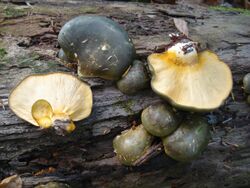Biology:Panellus serotinus
| Panellus serotinus | |
|---|---|

| |
| Scientific classification | |
| Domain: | Eukaryota |
| Kingdom: | Fungi |
| Division: | Basidiomycota |
| Class: | Agaricomycetes |
| Order: | Agaricales |
| Family: | Mycenaceae |
| Genus: | Panellus |
| Species: | P. serotinus
|
| Binomial name | |
| Panellus serotinus (Pers.) Kühner (1950)
| |
| Synonyms[1] | |
| |
Panellus serotinus, commonly known as the late oyster, is a species of fungus in the family Mycenaceae. Fruit bodies grow as overlapping fan- or oyster-shaped caps on the wood of both coniferous and deciduous trees. The gills on the underside are closely spaced, bright orange yellow, and have an adnate attachment to the stipe. It produces a yellow spore print; spores are smooth, amyloid, and measure 4–6 by 1–2 µm.[2] The caps are edible, but some people report the taste to be bitter—a factor that may depend on the host tree on which it is found.[3] In Japan, where it is called Mukitake, it is considered "one of the most delicious edible mushrooms", and a system has recently been developed to cultivate the mushroom in plastic greenhouses.[4] However, some guidebooks list it as inedible.[5]
References
- ↑ "Synonymy: Panellus serotinus (Pers.) Kühner". Species Fungorum. CAB International. http://www.speciesfungorum.org/Names/SynSpecies.asp?RecordID=433470.
- ↑ McKnight KH. (1998). A Field Guide to Mushrooms: North America. Houghton Mifflin Harcourt. p. 180. ISBN 0-395-91090-0. https://books.google.com/books?id=kSdA3V7Z9WcC&pg=PA180.
- ↑ Edible Wild Mushrooms of North America: A Field-to-kitchen Guide. University of Texas Press. 2010. p. 179. ISBN 978-0-292-79248-7. https://books.google.com/books?id=xLxaBAAAQBAJ&pg=PT179.
- ↑ "Effect of Mukitake mushroom (Panellus serotinus) on the pathogenesis of lipid abnormalities in obese, diabetic ob/ob mice". Lipids in Health and Disease 12: 18. 2013. doi:10.1186/1476-511X-12-18. PMID 23406154.

- ↑ Phillips, Roger (2010). Mushrooms and Other Fungi of North America. Buffalo, NY: Firefly Books. p. 245. ISBN 978-1-55407-651-2. https://archive.org/details/mushroomsotherfu0000phil.
External links
Wikidata ☰ Q1280426 entry

